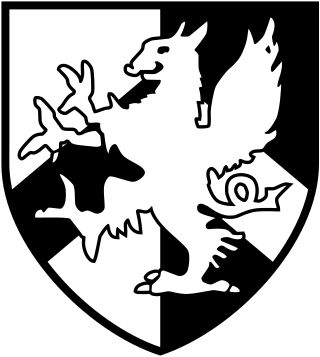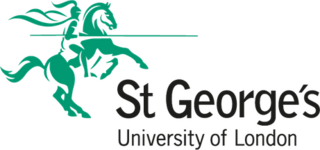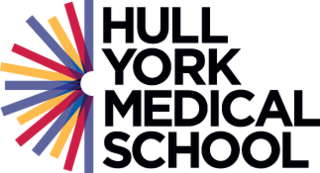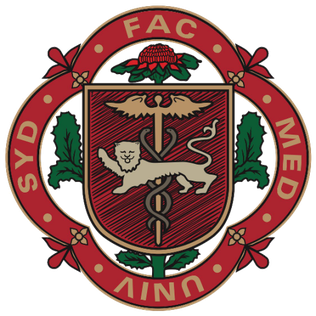
Barts and The London School of Medicine and Dentistry, commonly known as Barts or BL, is a medical and dental school in London, England. The school is part of Queen Mary University of London, a constituent college of the federal University of London, and the United Hospitals. It was formed in 1995 by the merger of the London Hospital Medical College and the Medical College of St Bartholomew's Hospital.

St George's, University of London (SGUL), legally the St George's Hospital Medical School, was a public university in South London, England. It merged with City, University of London to form City St George's, University of London in August 2024. The names "City, University of London" and "St George’s, University of London" will provisionally continue as trading names until March 2025.

The University of Nottingham Medical School at Derby was opened in September 2003 by Dr John Reid, then Secretary of State for Health. It is part of the University of Nottingham and is located in the nearby city of Derby in the East Midlands of England. It offers a four-year Graduate Entry Medical (GEM) course as well as a 3-year Undergraduate Medical Physiology and Therapeutics degree as well. It is currently led by Professor John Alcolado.
A Bachelor of Medicine, Bachelor of Surgery is a medical degree granted by medical schools or universities in countries that adhere to the United Kingdom's higher education tradition. Despite the historical distinction in nomenclature, these degrees are typically combined and conferred together. This degree is usually awarded as an undergraduate degree, but it can also be awarded at graduate-level medical institutions. The typical duration for completion is five to six years.

In the United Kingdom, medical school generally refers to a department within a university which is involved in the education of future medical practitioners. All leading British medical schools are state-funded and their core purpose is to train doctors on behalf of the National Health Service. Courses generally last four to six years: two years of pre-clinical training in an academic environment and two to three years clinical training at a teaching hospital and in community settings. Medical schools and teaching hospitals are closely integrated. The course of study is extended to six years if an intercalated degree is taken in a related subject.
Imperial College School of Medicine (ICSM) is the undergraduate medical school of Imperial College London in England and one of the United Hospitals. It is part of the college's Faculty of Medicine and was formed by the merger of several historic medical schools. Its core campuses are located at South Kensington, St Mary's, Charing Cross, Hammersmith and Chelsea and Westminster. The school ranked 4th in the world for medicine in the 2024 Times Higher Education World University Rankings.

Hull York Medical School (HYMS) is a medical school in England which took its first intake of students in 2003. It was opened as a part of the British government's attempts to train more doctors, along with Brighton and Sussex Medical School, Peninsula Medical School and University of East Anglia Medical School. It is the joint medical school of the Universities Hull and York. The University of Hull was rated Gold in the Teaching Excellence Framework 2023 as was the University of York. The latter is also a member of the Russell Group; an association of 24 world class, research intensive universities.

The University of Birmingham Medical School is one of Britain's largest and oldest medical schools with over 400 medical, 70 pharmacy, 140 biomedical science and 130 nursing students graduating each year. It is based at the University of Birmingham in Edgbaston, Birmingham, United Kingdom. Since 2008, the medical school is a constituent of The College of Medical and Dental Sciences.

Brighton and Sussex Medical School (BSMS) is a medical school formed as a partnership of the University of Brighton and the University of Sussex. Like other UK medical schools it is based on the principles and standards of 'Tomorrow's Doctors', an initiative by the General Medical Council outlining the role of British practitioners. Since opening in 2003, BSMS has produced more than 1,500 new doctors who now work across the UK.

Keele University School of Medicine is a medical school located in Newcastle-under-Lyme and Shrewsbury. The first two years of the school's MBChB degree are mostly taught on the Keele University campus, while early contact with patients is critical, and there is significant interaction in a clinical environment from the second year onwards.
The University of St Andrews School of Medicine is the school of medicine at the University of St Andrews in St Andrews, Fife, Scotland and the oldest medical school in Scotland.
Warwick Medical School is the medical school of the University of Warwick and is located in Coventry, United Kingdom. It was opened in 2000 in partnership with Leicester Medical School, and was granted independent degree-awarding status in 2007.

University of Southampton School of Medicine is a medical school in England. It is part of the University of Southampton with a site at Southampton General Hospital, offering 5 Medicine courses, all leading to the award of Bachelor of Medicine, Bachelor of Surgery (BMBS). Graduates of the BM5/BM6/BM(EU) programme are also awarded an integrated BMedSc (Hons) degree. Prior to 2013, the Bachelor of Medicine (BM) degree was awarded.

The School of Clinical Medicine is the medical school of the University of Cambridge in England. The medical school is considered as being one of the most prestigious in the world, ranking as 1st in The Complete University Guide, followed by Oxford University Medical School, Harvard Medical School, and Stanford School of Medicine and 2nd in the world in the 2023 Times Higher Education Ranking. The Cambridge Graduate Course in Medicine (A101) is the most competitive course offered by the University and in the UK, and is among the most competitive medical programs for entry in the world. The school is located alongside Addenbrooke's Hospital and other institutions in multiple buildings across the Cambridge Biomedical Campus.

The University of Sydney School of Medicine, also known as Sydney Medical School (SMS) is the graduate medical school of the University of Sydney. Established in 1856, it is the first medical school in Australia. In 2018, Sydney Medical School joined the newly formed Faculty of Medicine and Health at the University of Sydney. SMS is ranked 19th in the world and second in Australia in the 2021 QS Subject Rankings for medicine.
The University of Edinburgh Medical School is the medical school of the University of Edinburgh in Scotland and the United Kingdom and part of the College of Medicine and Veterinary Medicine. It was established in 1726, during the Scottish Enlightenment, making it the oldest medical school in the United Kingdom and the oldest medical school in the English-speaking world.

Swansea University Medical School is a medical school on Swansea University's Singleton campus. It is linked to additional teaching centres located throughout South and West Wales, including Cefn Coed Hospital, Singleton Hospital and Morriston Hospital in Swansea, Prince Philip Hospital in Llanelli, Withybush General Hospital in Haverfordwest and Bronglais Hospital in Aberystwyth. The Medical School also has a network of primary care teaching centers.

The University of Sheffield Medical School is a medical school based at the University of Sheffield in Sheffield, South Yorkshire, England. The school traces its history back to at least 1828. It operated independently until its merger with Firth College and Sheffield Technical School in 1897, and is now an integral part of Sheffield's Faculty of Health.
A Bachelor of Medical Sciences (BMedSci, BMedSc, BSc(Med), BMSc) is an undergraduate academic degree involving study of a variety of disciplines related to human health leading to an in depth understanding of human biology and associated research skills such as study design, statistics and laboratory techniques. Such disciplines include biochemistry, cell biology, physiology, pharmacology or psychosocial aspects of health. It is an equivalent level qualification to the more commonly awarded Bachelor of Science (BSc). Graduates may enter a diverse range of roles including post-graduate study, higher education, the biotechnology industry, the pharmaceutical industry, consultancy roles, scientific communication, education or unrelated disciplines which make use of the broad range of transferable skills gained through this degree.
Oxford University School of Medicine & Biomedical Sciences is the medical school of the University of Oxford in the city of Oxford, England. It is a component of the Medical Sciences Division, and teaching is carried out in its various constituent departments.














